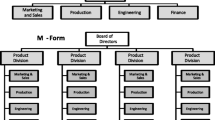Abstract
This paper argues that strategic management of a public interest organization not only needs to be aimed at the interests it represents, but it also has to incorporate the organization's internal workings. The functioning of a public interest organization is seen to suffer from a primary dilemma of membership and influence and a secondary dilemma of representation and control. If these dilemmas are not handled adequately, the public interest organization will suffer from a vicious circle of contradiction and conflict, eventually threatening the organization's long-term viability. A case study is elaborated to empirically underpin this proposition.
Similar content being viewed by others
References
Archer, M. (1982). Morphogenesis versus structuration: On combining structure and action. British Journal of Sociology 33(4), 455–483.
Barley, S. R. (1986). Technology as an occasion for structuring: Evidence from observations of CT scanners and the social order of radiology departments. Administrative Science Quarterly 31(1), 78–108.
Barney, J. B. (1986). Strategic factor markets: Expectations, luck, and business strategy. Management Science 32(10), 1231–1241.
Beltman, H. (2001). Een schets van de Nederlandse verstandelijk gehandicaptenzorg 1945–2000 [A sketch of the Dutch social services for mentally handicapped people 1945–2000], Bohn Stafleu Van Loghum, Houten, The Netherlands.
Berry, J. M. (1977). Lobbying for the People, Princeton University Press, Princeton, NJ.
Boardman, A. E., and Vining, A. R. (2000). Using service-customer matrices in strategic analysis of nonprofits. Nonprofit Management & Leadership 10(4), 397–420.
Eldenburg, L., Hermalin, B. E., Weisbach, M. S., and Wosinka, M. (2001). Hospital governance, performance objectives and organizational form, Working Paper 8201, National Bureau of Economic Research, Cambridge, MA.
FvO. (1993). Samenwerkende oudervereniging in de jaren '90 [Cooperating parent associations in the 1990s], Policy document, Federatie van Ouderverenigingen, Utrecht, The Netherlands.
FvO. (1996). Veelkleurige Samenwerking “Multicolored cooperation”, Policy document, Federatie van Ouderverenigingen, Utrecht, The Netherlands.
Giddens, A. (1979). Central Problems in Social Theory: Action, Structure and Contradiction in Social Analysis, Macmillan, Basingstoke.
Giddens, A. (1984). The Constitution of Society: Outline of a Theory of Structuration, Polity Press, Cambridge.
Grant, W. (1995). Pressure Groups, Politics and Democracy in Britain, 2nd edn., Harvester Wheatsheaf, New York.
Hampden-Turner, C. (1990). Charting the Corporate Mind: From Dilemma to Strategy, Basil Blackwell, Oxford.
Hampden-Turner, C. (1994). Corporate Culture: How to Generate Organizational Strength and Lasting Commercial Advantage: From Vicious to Virtuous Circles, Piatkus, London.
Hellgren, B., and Löwstedt, J. (1998). Agency and organization: A social theory approach to cognition. In: C. Eden and J. C. Spender (eds.), Managerial and Organizational Cognition, Sage, London, pp. 40–57.
Knoke, D. (1990). Organizing for Collective Action, Aldine De Gruyter, New York.
Mastenbroek, W. F. G. (1987). Conflict Management and Organization Development, Wiley, New York.
Mintzberg, H. (1994). The Rise and Fall of Strategic Planning, Prentice Hall, Englewood Cliffs, NJ.
Orlikowsky, W. J. (1992). The duality of technology: Rethinking the concept of technology in organizations. Organization Science 3(3), 398–427.
Pascale, R. (1990). Managing on the Edge: How Successful Companies Use Conflict to Stay Ahead, Penguin, London.
Pettigrew, A. M. (1985). The Awakening Giant: Continuity and Change in ICI, Basil Blackwell, Oxford.
Pettigrew, A. M., Thomas, H., and Whittington, R. (2002). Strategic management: The strengths and limitations of a field. In: A. M. Pettigrew, H. Thomas, and R. Whittington (eds.), Handbook of Strategy and Management, Sage, London, pp. 3–29.
Poole, M. S., and Van de Ven, A. H. (1989). Using paradox to build management and organization theories. Academy of Management Review 14(4), 562–578.
Porter, M. E. (1980). Competitive Strategy: Techniques for Analyzing Industries and Competitors, Free Press, New York.
Quinn, R., and Cameron, K. (eds.). (1988). Paradox and Transformation: Toward a Theory of Change in Organization and Management, HarperCollins, New York.
Ranson, S., Hinings, G., and Greenwood, R. (1980). The structuring of organizational structures. Administrative Science Quarterly 25(1), 1–17.
Saidel, J. R. (1998). Expanding the governance construct: Functions and contributions of nonprofit advisory groups. Nonprofit and Voluntary Sector Quarterly 27(4), 421–437.
Scapens, R. W., and Roberts, J. (1993). Accounting and control: A case study of resistance to accounting change. Management Accounting Research 4(1), 1–32.
Selsky, J. W. (1998). Developmental dynamics in nonprofit-sector federations. Voluntas 9(3), 283–303.
Streeck, W. (1992). Social Institutions and Economic Performance: Studies of Industrial Relations in Advanced Capitalist Economies, Sage, London.
Streeck, W., and Schmitter, P. C. (eds.). (1985). Private Interest Government: Beyond Market and State, Sage, London.
Valkenberg, B. (1995). Participatie in sociale bewegingen. Een bijdrage aan de theorievorming over participatie, emancipatie en sociale bewegingen [Participation in social movements. A contribution to the development of theory about participation, emancipation and social movements], Jan van Arkel, Utrecht, The Netherlands.
Van Waarden, F. (1992). Organizational emergence and development of business' interests: An example from The Netherlands. Organization Studies 13(4), 521–561.
Watson, T. J. (1994). In Search of Management: Culture, Chaos and Control in Managerial Work, Routledge, London.
Wernerfelt, B. (1984). A resource-based view of the firm. Strategic Management Journal 5(2), 171–180.
Whittington, R. (1992). Putting Giddens into action: Social systems and managerial agency. Journal of Management Studies 29(6), 693–712.
Willmott, H. (1987). Studying managerial work: A critique and a proposal. Journal of Management Studies 24(3), 249–270.
Yin, R. K. (1994). Case Study Research: Design and Methods, 2nd edn., Sage, Thousand Oaks, CA.
Young, D. R., Koening, B. L., Najam, A., and Fisher, J. (1999). Strategy and structure in managing global associations. Voluntas 10(4), 323–343.
Author information
Authors and Affiliations
Rights and permissions
About this article
Cite this article
Pijl, K.v.d., Sminia, H. Strategic Management of Public Interest Organizations. VOLUNTAS: International Journal of Voluntary and Nonprofit Organizations 15, 137–155 (2004). https://doi.org/10.1023/B:VOLU.0000033178.54004.e9
Issue Date:
DOI: https://doi.org/10.1023/B:VOLU.0000033178.54004.e9




